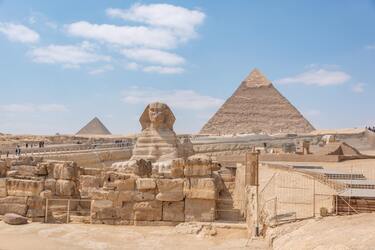How old are the Egyptian pyramids really: explanation of scientists

The Egyptian pyramids have always been symbols of the power of ancient pharaohs and the skill of technological construction. However, their antiquity and purpose have always been the subject of debate among scientists.
Live Science analyzed when exactly the first pyramids appeared and why they were built.
It is noted that the first pyramid in Egypt was built by Pharaoh Necherykhet (Djoser), who ruled almost 4700 years ago. It consists of six layers and was originally built as a type of rectangular tomb, known today as a mastaba, and then expanded into a stepped pyramid.
Read also: A huge statue of a little-known pharaoh was discovered in Egypt
More than a millennium later, the last pyramid of ancient Egypt built for a pharaoh was built for Yahmose I approximately 3500 years ago. After that, the Egyptian rulers were buried in underground tombs in the Valley of the Kings.
The publication writes that the ancient Egyptian pyramids were built sometime between 2700 BC and 1500 BC.
The pyramid of Djoser
Its construction was led by a man named Imhotep, who is considered the first architect in Egypt. He built it out of stone.
Columbia University history professor Mark Van De Mirope noted: "There is an inscription with his name combined with the name of Djoser, in which he is named as the main sculptor. In later Ancient Egypt, he was considered a sage."
Why did the Egyptians build pyramids?
Researchers are still not sure why the pharaohs decided to use pyramids for their burials.
Many Egyptologists have speculated that the stepped pyramid formed a kind of "staircase" for the king to ascend to heaven, while others have suggested that the pyramids protected the tombs from thieves.
Religious reasons could also have been an important factor. Miroslav Werner, professor emeritus of Egyptology at Charles University in the Czech Republic, told Live Science in an email that "there were probably religious reasons behind the idea of building the pyramids."
The growing influence of sun worship may have led to a desire to build structures that would reach higher into the sky. Werner noted that a passage from a text dating from around 4400 years ago reads: "May the sky make the sunlight strong for you, may you rise to the sky like the Eye of Ra."
Massimiliano Nuzzolo, a researcher at the Institute of Mediterranean and Oriental Cultures at the Polish Academy of Sciences in Warsaw, noted that interest in the solar cult grew after the construction of the step pyramid.
Read also: A perfectly preserved embryo was found inside a fossilized dinosaur egg for the first time (photo)
Built to last for millennia
Whatever the reasons for the construction of the pyramids, Egyptian pharaohs built them for more than a millennium. Pharaoh Sneferu (reigned ca. 2575-2551 BC) built the first true pyramids (pyramids with flat sides) at Dahshur. They consisted of the Bent Pyramid (so named because of its unusual angle) and the Red Pyramid (named for its color). The Great Pyramid at Giza, the only one of the Seven Ancient Wonders of the World still standing, was built by Khufu (reigned ca. 2551-2528 BC), while Chephren (reigned ca. 2520-2494 BC) built another large pyramid along with the Great Sphinx at Giza.
"It is unclear why the Egyptian pharaohs stopped building pyramids, but it may have been due to security concerns. Although they are probably harder to plunder than the mastabas, the Egyptian pyramids were plundered in ancient times, and the pharaohs may have hoped that the construction of their tombs in the Valley of the Kings would make them more difficult to plunder," the publication writes.
As a reminder, a 1,400-year-old treasure was found in Israel.
If you want to get the latest news about the war and events in Ukraine, subscribe to our Telegram channel!
